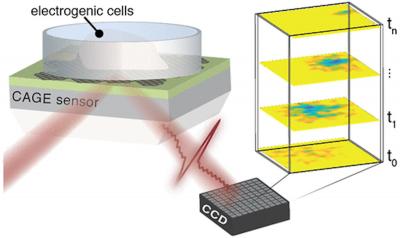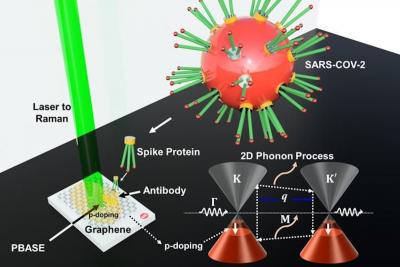The Graphene-Info weekly newsletter
Published: Tue, 06/22/21
Graphene Flagship Partner SPAC updates on graphene-enhanced automotive components project
SPAC, an Italy-based medium-sized company specializing in the production of technical textiles, has joined the Graphene Flagship's Spearhead Project G+BOARD that aims to build parts of cars’ passenger compartments with graphene and related materials.
G+BOARD’s researchers aim to remove most of the copper wiring currently used in dashboards, to reduce the car’s weight and production steps, while improving aesthetics, disposal and recyclability. SPAC is developing new steering wheels and glove boxes with graphene-based materials.
'Graphene camera’ captures real-time electrical activity of beating heart
Scientists from UC Berkeley and Stanford University have captured the real-time electrical activity of a beating heart, using a sheet of graphene to record an optical image — almost like a video camera — of the faint electric fields generated by the rhythmic firing of the heart’s muscle cells.

The 'graphene camera' is a new type of sensor that could prove useful for studying cells and tissues that generate electrical voltages, including groups of neurons or cardiac muscle cells. To date, electrodes or chemical dyes have been used to measure electrical firing in these cells. But electrodes and dyes measure the voltage at one point only; a graphene sheet measures the voltage continuously over all the tissue it touches.
Researchers develop graphene-based sensors that detect COVID-19 quickly and efficiently
Researchers at the University of Illinois Chicago (UIC) have used sheets of graphene to rapidly detect COVID-19 in laboratory experiments, an advance that could potentially detect variants of the virus.
 The white rectangle represents the substrate with graphene functionalized with SARS-CoV-2 antibody (shown in yellow). When the graphene detector interacts with the virus’ spike protein in a COVID-positive sample, its atomic vibration frequency changes.
The white rectangle represents the substrate with graphene functionalized with SARS-CoV-2 antibody (shown in yellow). When the graphene detector interacts with the virus’ spike protein in a COVID-positive sample, its atomic vibration frequency changes.
According to UIC, the researchers combined sheets of graphene with an antibody designed to target the spike protein on the coronavirus. They then measured the atomic-level vibrations of these graphene sheets when exposed to COVID-positive and COVID-negative samples in artificial saliva. The sheets were also tested in the presence of other viruses, such as Middle East respiratory syndrome.
New graphene-based aerogel could reduce aircraft engine noise
University of Bath researchers have developed a graphene-based light material that can reduce aircraft engine noise and improve passenger comfort.

The graphene oxide-polyvinyl alcohol aerogel weighs just 2.1kg per cubic meter, making it the lightest sound insulation material ever manufactured. It could be used as insulation within aircraft engines to reduce noise by up to 16 decibels - reducing the 105-decibel roar of a jet engine taking off to a sound closer to that of a hair-dryer.
New project aims to turn urban waste into graphene and other useful materials
Graphenea will be taking part in a flagship project called CIRCULAR BIOCARBON, which was kicked off this week and has been awarded over €23 Million, to develop a first-of-its kind flagship biorefinery designed to turn the organic fraction of municipal solid waste (OFMSW) and sewage sludge (SS) into added-value products, from mechanical moving parts, to night vision cameras and devices for 5G telecommunications.
The project, which received full marks from the European Commission, involves 11 partners from five European countries (including Spain, Italy, Denmark, France and Germany) and is a milestone for the whole Europe owing to its implementation scale (industrial level) as well as to its replicability potential.
AMD and First graphene to collaborate on development of graphene inks and coatings
Advanced Material Development (AMD) and First Graphene have agreed to collaborate on the ongoing development of AMD’s conductive inks and other graphene enabled coatings.
Under a binding memorandum of understanding (MoU), AMD will provide expertise in the design and development of functional nanomaterials and hierarchical assembly of material systems, while First Graphene delivers capabilities in the development, manufacture and supply of its graphene nanoplatelets, branded PureGraph.
NanoXplore enters agreement to Supply Techmer PM with GrapheneBlack™
NanoXplore has announced that it has entered into a multiyear agreement to supply GrapheneBlack™ grade of products to Techmer PM, a large U.S-based plastic compounder specializing in modifying and fine-tuning the properties of technical polymers. Techmer PM will market its graphene-enhanced plastic compounds to a variety of industries in a number of diverse end uses and applications.
Techmer PM’s aim is to provide the highest performance properties possible across a wide spectrum of compounds and end products.
Researchers develop a graphene-based phonon laser
A team of researchers, led by Professor Konstantin Arutyunov of the HSE Tikhonov Moscow Institute of Electronics and Mathematics (MIEM HSE), has developed a graphene-based mechanical resonator, in which coherent emission of sound energy quanta, or phonons, has been induced. Such devices, called phonon lasers, could have wide potential for applications in information processing, as well as classical and quantum sensing of materials.
Using an analogy with photons, quanta of the electromagnetic spectrum, there are also particles of sound energy, phonons. In fact, these are artificially introduced objects in physics—quasi-particles, which correspond to vibrations of the crystal lattice of matter.
Graphene-enhanced cement could help build more durable roads and cities
Northwestern University researchers have added graphene nanoplatelets to cement, resulting in smarter, more durable and highly functional cement.
With cement being the most widely consumed material globally and the cement industry accounting for 8% of human-caused greenhouse gas emissions, civil and environmental engineering professor Ange-Therese Akono turned to nanoreinforced cement to look for a solution. Akono, the lead author on the study and an assistant professor in the McCormick School of Engineering, said nanomaterials reduce the carbon footprint of cement composites, but until now, little was known about its impact on fracture behavior.
AMD secured U.S Government contract to develop films for laser protective eyewear
Advanced Material Development (AMD) has been awarded a US Government contract to develop protective films to be integrated into protective eyewear. The contract with the Irregular Warfare Technical Support Directorate (IWTSD, formerly CTTSO) will fund AMD’s development of laser filtering coatings, based on AMD’s nanomaterial and photonic crystal technologies.
AMD incorporates few layer graphene (FLG) into a polymeric substrate to create the photonic crystals which are the foundation of their platform technology.




